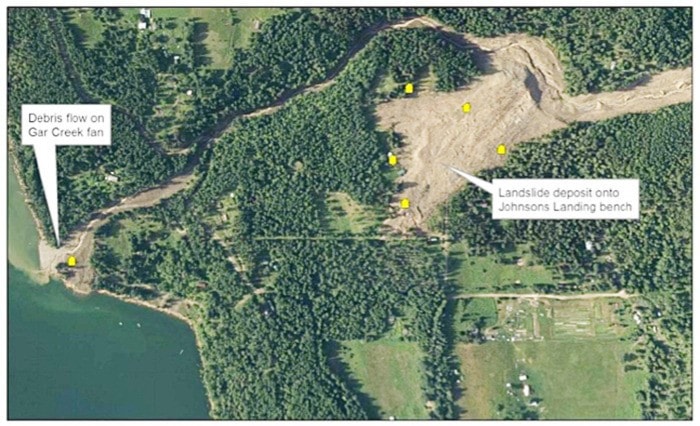Some Johnsons Landing residents who saw their community devastated by last year’s massive landslide are looking for options to dispose of their properties.
A report released last week shows the risk of future landslide activity remains high in the area and some homes may never be safe to occupy. Government agencies provided financial support to residents who had their primary residence or business destroyed in the landslide, but stopped short at buying the unsafe properties to turn them over to Crown land.
“The land remains in private hands, therefore the liability is in the hands of that homeowner,” resident Kate O’Keefe explained to 103.5 The Bridge.
O’Keefe’s home is outside the slide zones, though her husband lost his property in the disaster. He received no compensation through the Disaster Assistance Program because it wasn’t his primary residence and home insurance doesn’t cover natural disasters. They’d like to sell the property, but doubt they’d find a buyer.
“Nobody’s going to buy land they can’t occupy,” O’Keefe said. “I would like to see the land purchased by the Crown, made into Crown land, and not available for public use.”
But David Curtis, executive director of emergency services for Emergency Management BC, said that’s unlikely to happen at a provincial level.
“There is no mechanism within the province to actually buy neighbourhoods that have been affected by disasters,” Curtis said in a media conference last week.
He noted his agency has already provided some $300,000 in compensation to Johnsons Landing residents and there are still funds to distribute.
Curtis characterized the disaster as an “act of God” and though the slide originated on Crown land he said the province isn’t liable for what happened.
“There was no upslope work that caused it to happen,” he said. “It was an unpredictable event.”
Dawn Attorp, general manager of corporate administration for the Regional District of Central Kootenay, said district staff have met one-on-one with Johnsons Landing residents to explain the risks outlined in the report. An RDCK sub-committee is evaluating the recommendations in the report over the next several months to establish new landuse regulations for the area.
“The current evacuation order will likely remain in effect until the board has made some decisions about land use regulations,” Attorp said in the media conference.
For O’Keefe, the news she got from the report and RDCK staff is worse than she expected. The area up slope of the community that could release in a subsequent landslide spans about 90 hectares and is too large to stabilize.
“There is more material still up there than I expected,” O’Keefe told The Bridge.
“The probability of it coming down really comes down to weather; if we have another year with high snow pack and heavy rains, the result could be devastating.”
